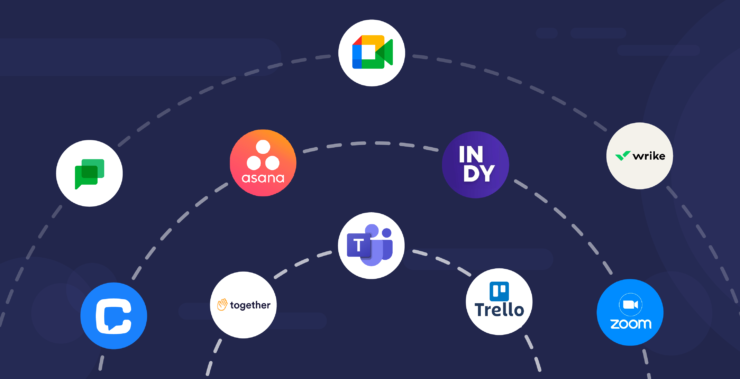Hybrid work has become commonplace in the aftermath of the Covid-19 pandemic. Teams who once had a fine-tuned rhythm for managing projects were suddenly forced to learn how to work together from miles apart.
Although communication tools have made remote work much more efficient, it hasn’t been without its hiccups. A quick search for “Zoom call fails” on YouTube will bring up a host of funny video call mishaps to brighten your day (and maybe even make you feel a little better about your own calls).
These awkward moments made people adapt how they communicate with coworkers through technology barriers, creating a need for greater communication competence in the digital workplace.
In this article, we’ll discuss what communication competence is and which tools are paving the way for the new normal of hybrid workplaces.
What is communication competence and why does it matter?
Communication competence is a person’s ability to achieve communicative goals in a socially appropriate manner. It’s how we relay information to each other in an easy-to-understand way. Just as important is the ability to adjust the ways we communicate to fit any given context.
For example, coworkers who adapted to a work-from-home setting showed signs of high communication competence, as they were able to adjust their communication style to fit a hybrid workplace.
There are many things that can impact a person’s communication competence, including age, education, language skills, and cultural barriers.
Cheryl Keates, a leadership coach, published an article for Forbes stating the five C’s for effective communication. They are as follows:
- Clear: Identify what you want and speak in a straightforward manner.
- Concise: Express the issue as directly and briefly as possible.
- Compelling request: Make sure people know exactly what you are asking of them.
- Curious: Curiosity improves collaboration and engagement within teams.
- Compassionate: Have empathy for other people’s thoughts and feelings.
These pillars help us assess and know how to respond to different situations, keeping a happier and healthier coworking relationship among team members. But just how important is having good communication in the workplace?
According to Salesforce, 86% of executives said that poor communication is a major reason why businesses fail. That’s because teams that lack strong communication are likely to miss deadlines, overshoot budgets, and create unnecessary bottlenecks in the flow of a project.
While team members used to have the luxury of face-to-face conversations to pick up on verbal and nonverbal cues, the switch to a hybrid workplace meant that team members no longer had the same level of communication they once had in an office setting.
Without a strong system to align team members on projects, even the most efficient teams can fall apart when separated by long distances. This is why communication tools have become an important development in elevating communication competence for hybrid workplaces.
How can tools improve communication competence?
Because of the complexity of today’s projects, it’s no longer enough for coworkers to simply fall back on emailing to manage projects, which is why communication tools have become so critical in a hybrid workplace. An individual’s communication competence can be severely impacted without the ability to see a co-worker’s face.
For that reason, communication tools give teams a way to collaborate by text, voice, and video to ensure projects continue to flow as smoothly as they did within the confines of their businesses. Operating online, a cloud-based contact center integration also makes the customer communication process easy.
Here is how team chat tools help to solve the five C’s of effective communication we mentioned earlier:
- Transparency: Team members can see where each team member is at in the project timeline.
- Clarity: Apps provide an outlet for people to ask important questions to gain a better understanding of their role in the project.
- Reliability: Everyone is just a notification away from being able to jump on a call or hop into a message thread.
Arguably the biggest component to completing projects successfully is for teams to be able to connect with each other. Fortunately, there are many communication tools that are packed with incredible features to help teams thrive in the hybrid workplace.
10 Tools for communication competence
Whether you’re speaking through video chats or sending written messages through apps, strong communication skills need to be developed through different modes of communication. These are the top tools that provide seamless communication in a hybrid work model.
Apps for messaging
The first area that hybrid teams need to engage with for greater communication competence is messaging. Although emails still have a place, it’s much more efficient to send a quick message over a chat app.
These apps are perfect for getting quick answers to questions, sending files, and handling conversations outside a video conference. Here are some of the best apps to elevate a hybrid workplace.
1. Chanty
Chanty is an excellent team messaging app for synchronous communication. It offers a feature called Teambook to keep your files, links, tasks, and conversations organized into folders. Its highly intuitive interface gives you the ability to chat through public and private channels to keep team messages organized.
Unlike some of the other messaging apps, Chanty doesn’t limit the searchable message history, so you can instantly find what you need. One of Chanty’s best features is the built-in task manager that lets you turn messages into tasks so that projects flow smoothly.
Core features:
- Unlimited messaging
- Easy-to-use video conferencing
- Flexible and visual all-in-one task management
- Creates workflow around different tasks, and helps start task discussion with your team with one click
- Prioritize your tasks easily, and get notified about deadlines
Pricing:
Free Plan: For up to 5 users! Get built-in task management, 20GB of storage (per team), one-on-one audio calls, public and private conversations, and much more.
Business Plan: $3/user/month billed annually. Includes everything from the free plan, plus video-calls feature with your team, 20GB of storage (per user), unlimited app integrations, and much more.
Enterprise Plan: Custom pricing for larger teams. Includes all Business Plan features, plus advanced security, unlimited storage, team analytics, dedicated support, and compliance features for scalable collaboration and enhanced control.
2. Together Platform
Part of nurturing a great hybrid work culture is giving your team members the mentorship they need. Together Platform helps create meaningful relationships between mentors and mentees.
With workplace mentoring, employees can get guidance and feedback from mentors to help accelerate their personal and professional development, which goes a long way in improving communication competence.
Together Platform’s algorithm can analyze team members to find the best mentor pairings for each person. The platform is incredibly intuitive, making it easy for teams to find exactly what they’re looking for. You can also measure how well the mentorship program is working with advanced reporting.
Core features:
- Workplace mentoring
- Collect critical information from your employees in minutes
- Integrates with emails and calendars for smooth scheduling
- Customizable HR dashboard
- Great customer support
Pricing:
Professional Plan: $10,000/yr minimum. For companies with under 500 employees. Includes everything from the starter plan, plus integration with video conferencing tools, unlimited pairings and sessions, onboarding support, single sign-on, and security reports.
Enterprise Plan: $20,000/yr minimum. For companies with over 500 employees. Includes everything from the professional plan, plus get a dedicated customer success manager, HRIS integration, multilingual programs, and data residency.
3. Google Chat
Formally called Hangouts Chat, Google rebranded the app into Google Chats. It’s Google’s take on a messaging app, and, since it’s a Google product, it also integrates with other Google tools like Google Meets and Google Drive.
Within chats, you can share spreadsheets and other documents found on your Google Drive profile. It also has a predictive text option that generates auto-responses, similar to the way Gmail does.
Core features:
- Shows you when someone is typing
- Offers read receipts (shows when someone has read or received your message, as well as showing your contact when you read their message)
- Send messages over mobile data and Wi-Fi
- Lets you share files and high-resolution photos
Pricing:
Free Plan: Included at no additional cost for people with Google accounts.
Apps for managing projects
A robust project management app will be critical to your hybrid team’s workflow, so it needs to have plenty of key features that can accommodate different workflows.
The risk for hybrid teams is that team members may not know what everyone’s roles are in a project, which is where project management software can step in and bring clarity to who is assigned to which tasks.
Here are some of the best platforms to manage projects.
4. Asana
Asana is a project management platform that helps hybrid teams improve their agile workflow. You’ll get task management tools, team collaboration, file sharing, and more.
The app lets you create to-do lists and get a view of projects in several different ways with boards, lists, calendars, portfolios, and timelines. You can also automate recurring tasks with options to build custom rules and approval workflows.
Core features:
- Get a high-level look at the team’s workload
- Kanban boards
- Custom fields
- Templates
- Portfolios
Pricing:
Personal: Free for individuals or small teams of up to 10 members. Includes unlimited tasks, projects, messages, activity logs, and file storage (100MB per file). Offers list, board, and calendar views, as well as over 100 free integrations.
Starter: Priced at $10.99 per user per month when billed annually. Includes all Personal plan features, plus Timeline and Gantt views, Workflow Builder, unlimited dashboards, advanced search, and custom fields. Supports up to 500 users.
Advanced: Priced at $24.99 per user per month when billed annually. Includes all Starter plan features, plus Portfolios, Goals, Workload, custom rules builder, forms branching and customization, approvals, and advanced reporting metrics.
Enterprise: Custom pricing tailored for large organizations. Includes all Advanced plan features, plus advanced security measures, administrative controls, data export options, and dedicated support.
Asana
Enterprise+: Custom pricing for organizations requiring strict compliance and flexible controls. Includes all Enterprise features, plus audit log and API, SIEM and DLP integration support, eDiscovery, archiving integration, enterprise key management, HIPAA compliance, and data residency options for global data management.
5. Indy
Indy is an all-in-one project management software that works great for freelancers and entrepreneurs who need to collaborate with clients. You can create and manage tasks with multiple views for getting work done, including boards and lists.
With version control, clients can leave comments right on the project files for easy collaboration. You can also keep track of work time by using time tracking. Indy‘s useability is as easy as it gets, making it a great option for freelancers and small business owners who need software they can dive into within just a few minutes of signing up.
Core features:
- Task management
- Automatic time tracking
- Calendar
- Forms
- Chats
- Invoice, contracts, and proposal templates
Pricing:
Free Plan: Comes with unlimited tasks, a calendar, and chats. It also comes with 15 time tracks, 2 contracts, 2 invoices, 2 proposals, 2 forms, and 1 GB of file storage.
Pro Bundle: For $18.75/month, you get access to unlimited time tracks, contracts, proposals, invoices, forms, tasks, calendar, chats, and 500 GB of file storage.
6. Wrike
Wrike is tailored to marketing agencies and service providers and allows for unlimited members. It has an easy-to-use dashboard and comes with customizable workflows, reports, and request forms.
It also features task lists, schedules, shared workflows, and real-time collaboration on projects. Before assigning a task to a team member, you can check their workload to get a feel for how busy they are already. But all of these features come with a pretty steep price tag per user that we’ll get to below.
Core features:
- Tasks and subtask management
- Interactive Gantt charts
- Custom workflows
- Internal and external collaborators
- Interactive board and spreadsheet views
- Time tracking
- Cloud storage integrations
Pricing:
Free Plan: Wrike does offer a free plan that includes things like task management, interactive board and spreadsheet views, and a personalized app experience, but many important features are restricted to their paid plans.
Team: $10/user/month. Includes everything from the free plan, plus shareable dashboards, interactive Gantt charts, productivity integrations, and up to 2 GB of storage per user.
Business: $25/user/month. Includes everything from the professional plan, plus features like custom fields, custom workflows, project blueprints, custom item types, branded workspace, automation engine, request forms and calendars, time tracking, and project and task approvals.
7. Trello
Trello helps teams navigate projects through simple Kanban boards that provide a visual on how tasks are progressing through the timeline. You can assign tasks to teammates, get customized workflows, attach files, and leave comments. If you need to collaborate on video projects, you can also consider using a video annotation tool to enhance communication and feedback during the editing process.
However, it’s missing some of the advanced features for tackling more complex projects. Similar to Wrike, Trello’s plans charge per user, making it a more expensive option for teams.
Core features:
- Kanban boards
- Workflow automation
- Custom fields
- Multiple project views
- Workspaces
Pricing:
Free Plan: Includes up to 10 boards per workspace, unlimited cards, unlimited Power-Ups per board, unlimited storage (10MB/file), 250 Workspace command runs per month, and custom backgrounds and stickers, and unlimited activity log.
Standard: $5/user/month. Includes everything from the free plan, plus unlimited boards, advanced checklists, custom Fields, unlimited storage (250MB/file), 1,000 Workspace command runs per month, single board guests, and saved searches.
Premium: $10/user/month. Includes everything from the standard plan, plus different views including calendar, timeline, table, dashboard, and map. Different workspace views, including table and calendar. Additionally, you’ll get unlimited Workspace command runs, admin and security features, workspace-level templates, collections, and observers.
Enterprise: $17.50/user/month. Includes everything from the premium plan, plus unlimited Workspaces, organization-wide permissions, organization-visible boards, public board management, multi-board guests, attachment permissions, and Power-Up administration.
Apps for team meetings
Video chats help hybrid teams regain the much-needed visual and oral communication that would otherwise be lost on teams working from home.
No matter how smooth a team’s written communication is through messaging apps, there’s always a need to hop on a conference call to sync team member’s on weekly planning and reviews.
Here are the top platforms for hybrid teams to accomplish their meetings.
8. Zoom
Zoom burst onto the scene during the Covid-19 pandemic as a highly reliable way to keep teams synced. You can record calls, share your screen for presentations, raise your hand to reduce interruptions, and even split off into different video chats after important conference meetings.
Some of its unique features include live polling, whiteboards, and the ability to annotate videos. While security posed an issue near the beginning of the pandemic, Zoom’s security has improved over time with end-to-end encrypted calls.
Core features:
- HD video and audio collaboration
- Video webinars
- Enterprise cloud phone system
- Whiteboards
Pricing:
Free Plan: Up to 100 attendees with a 40-minute call limit, access to group communication and file sharing, plus 3 whiteboards.
Pro Plan: $149.90/year/user. Includes everything from the free plan, plus up to 100 attendees with no call time limit and 5 GB of storage.
Business Plan: $199.90/year/user. Includes everything from the pro plan, plus up to 300 attendees and unlimited whiteboards.
Business Plus: $250.00/year/user. Includes everything from the business plan, plus unlimited Zoom Phone regional calls.
9. Google Meet
Google is back on the list for a second time with its video chat service, Google Meet. The benefit of using Google Meet for meetings is how it integrates with Google’s other popular apps.
You can schedule meetings in Google Calendar, join calls from Gmail, and share Google Drive files right in the chat. For people who already have a Gmail account, Google Meet is the easiest to get started with and is free for basic calling features.
Core features:
- Present documents, slides, and spreadsheets
- Invite up to 500 internal or external people to the chat
- Livestream to 100,000 viewers within your domain
- Join from your phone
Pricing:
Free Plan: Join and host unlimited meetings for up to 60 minutes per chat.
Business Starter: For $6/month, you get access to 100 participant video meetings, 30 GB of storage per user, and added security and management tools.
Business Standard: For $12/month, you get access to 150 participant video meetings + recording and 2 TB storage per user.
Business Plus: For $18/month, you get access to 500 participant video meetings + recording and attendance tracking. 5 TB storage per user. Plus, enhanced security and management control, including Vault and advanced endpoint management.
10. Microsoft Teams
Microsoft Teams is one of the best ways for teams to collaborate as it comes loaded with features, with one of the best free plans out there.
For teams that are already in the Microsoft ecosystem, this app will be an appealing option. Microsoft Teams features screen sharing, live captioning, call recording, and group chats.
Core features:
- Video meetings for up to 10,000 members
- Host webinars
- Share annotations
- Real-time captioning
Pricing:
Free Plan: Unlimited one-to-one meetings for up to 30 hours long, unlimited group meetings for up to 60 minutes, up to 100 participants per meeting, 5 GB of cloud storage per user, unlimited chat with coworkers and customers, file sharing, tasks, and polling. And data encryption for meetings, chats, calls, and files.
Microsoft Team Essentials: $4/user/month. Includes everything from the free plan, plus unlimited group meetings for up to 30 hours, up to 300 participants per meeting, 10 GB of cloud storage per user, and anytime phone and web support.
Microsoft 365 Business Basic: $6/user/month. Includes everything from Team Essentials, plus team meetings recordings with transcripts, web and mobile versions of Office apps 3, expanded cloud storage of 1 TB per user, business-class email, and standard security.
Microsoft 365 Business Standard: $12.50/user/month. Includes everything from 365 Business Basic, plus desktop versions of Office apps with premium features, webinar hosting, and attendee registration and reporting tools. You can also manage customer appointments.
Final thoughts
Businesses all over the globe have seen first-hand that not only can teams still function remotely, but that employees have found ways to thrive while working from home. However, the need for greater communication competence is vital for the success of a digital workplace.
The tools mentioned above, provide great features that bring transparency, clarity, and reliability to conversations between team members, ensuring that everyone stays on the same page.








